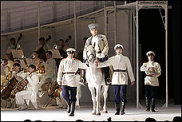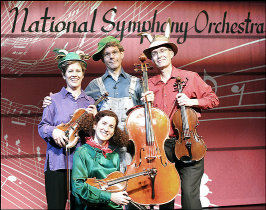Guitarist Adam Holzman plays Cruz, Assad
January 29, 2007
________________________________________________________________________

Adam HolzmanThe Washington Post 1/29/07: Classical guitarist Adam Holzman, who's becoming increasingly renowned for his thoughtful and finely polished interpretations, brought his considerable talents to the Westmoreland Congregational Church on Saturday, as part of the Marlow Guitar Series. And he showed himself to be an assured and uncommonly lucid player, with a precise touch, a rare gift for voice-leading and impressive attention to detail in virtually everything he played.
Those virtues notwithstanding, it still took much of the program for Holzman to really get under the skin of the music. He delivered three of Domenico Scarlatti's sonatas -- works rich in strange and edgy imagination -- with cool efficiency, then followed with his own transcription of Johann Sebastian Bach's Suite No. 3 for solo cello. It's a powerful and almost confessional work, with startling emotional turns -- even its depths have depths, as they say -- and Holzman's transcription is quite persuasive. But he played it almost as an etude; graceful rather than probing, and lacking in much to grab you by the ears.
But the waters deepened considerably after intermission, with a beautifully detailed account of "Triptych" by Texas-based composer Mark Anthony Cruz. Highly impressionistic and colorful at first, it deepens into more abstract territory and culminates in a dark, richly flavored and highly evocative movement, and Holzman played it with real understanding.

Sergio Assad"Three Greek Letters," by the Brazilian composer and guitarist Sergio Assad, was, if anything, even better. It's an extremely intelligent and very "guitaristic" work, brilliantly textured and passionately intense, that displays Assad's sophisticated and highly individual voice to great advantage. Holzman rose to the challenge, bringing it off with conviction and style.
Italian Opera, Eastern European style
January 29, 2007
__________________________________________________________________________

Galina Stoyanova
We caught the Bulgarian State Opera's production of "Tosca" on Friday at George Mason -- and let me tell you, it wasn't a pretty sight. Weak voices, limp stage direction, and a generally clunky and industrial event in every way. Tom Huizenga has a review in today's Post that sums it up precisely: "mostly a disappointment," he says, with "asthmatic winds and sour strings" in the ill-led orchestra, and a Tosca (the young Galina Stoyanova) who "opted for an evening-long pout" rather than trying to actually act.
Tom didn't mention some of the more wonderful moments, like the slide-animated Madonna who wept blood (priceless) and Stoyanova's dainty little hop as she threw herself to her death at the end, which had us trying desperately not to laugh. But as we quickly got up to leave, I looked over my shoulder -- and the troupe was getting a standing ovation.
Natasha RazinaThe Kirov Opera is also in town, and presented Gioachino Rossini's "Il Viaggio a Reims" at the KenCen this weekend; didn't get to see it, but the Post's Tim Page has a review today. It sounds wild: "caustic, clever and appropriately wacky," says Page, with a set that calls to mind "that ocean liner the Marx Brothers could never quite escape in "Monkey Business," complete with a gangplank into the audience."
Despite "much at which to marvel", though, he found the music had a "hard Eastern European severity" and was "declaimed rather than caressed."
The Kirov is putting on Giuseppe Verdi's "Falstaff" this week, and a concert version of Dmitri Shostakovich's "Lady Macbeth of Mtsensk" next Sunday, also at the Kennedy Center.
Yuri Bashmet and the Moscow Soloists
January 26, 2007
________________________________________________________________________
Yuri BashmetThe Washington Post 1/26/07: It would seem to make sense -- geographically, at least -- that Russian musicians are well placed to bridge the gap between East and West. Viola superstar Yuri Bashmet and his chamber orchestra, the Moscow Soloists, put that premise to the test Wednesday, when they brought a program of new, culture-blending Asian music to the Library of Congress. The results, while fascinating and often even brilliant, were mixed.
The evening opened with Toru Takemitsu's "Nostalghia." Takemitsu is a master of emotionally complex atmospherics, and "Nostalghia" is steeped in quiet anguish, with spare and regretful gestures from the violin sketched out against dark, slow-moving clouds of sound in the orchestra. Beautifully written -- but if it sounds heavy and a bit suffocating, that's because ot was. While Bashmet delivered an eloquent and probing performance, there was a collective sigh of relief when, at the end, we could all surface for air.
The Concerto for Pipa and String Orchestra, by the Chinese composer Tan Dun, couldn't have been more different. The pipa is a traditional four-string lute, and you expect a delicate, flowery opening. But the piece is literally kick-started with a collective stamp of the feet, and surges into a pulsing, elemental movement thick with Chinese melodies -- as wild and extroverted as the Takemitsu was introverted. The players strum, pluck and pummel their instruments, letting loose loud cries of "yao!" from time to time -- and lutenist Wu Man more than held her own, unleashing her pipa in an explosion of virtuosity and kinetic power.

Wu ManBut while it's a hugely entertaining ride, the concerto careens shamelessly among kitschy folk melodies, snatches of recycled Bach and hokey tunes redolent of Chinese opera, and even flirts a bit with Bartok. Tan Dun clearly has a sense of humor -- at one point the orchestra members stand up and pretend-tune to the pipa, to mark the transition to a Western style. But it's hard to avoid the feeling that he's hurling a little too much postmodern irony at you.
The program headed back into deeper waters with Hikaru Hayashi's viola concerto "Elegia" -- a remarkable piece, with a fine romantic and narrative sweep that's well worth the attention it demands. But Bashmet never quite recovered from an insecure start, and rarely seemed fully sure where he was taking the piece. Three short and rather ordinary film scores by Takemitsu closed out the program.
But in an intriguing coda to the evening, the ensemble dropped the East-West fusion theme and went directly to their roots, playing two encores by Russian composers Igor Stravinsky and Alfred Schnittke. The transformation was immediate and astonishing -- as if the players had all suddenly snapped into focus, and were playing directly and deeply from the blood.
Musica Pacifica at Strathmore
January 23, 2007
________________________________________________________________
 The Washington Post 1/23/07: The late 17th century was a heady time to be a musician in the British Isles. The death in 1685 of the puritanical Oliver Cromwell unleashed a storm of creativity, and a wealth of unusual new music -- ranging from the grotesque to the sublime -- was the result.
The Washington Post 1/23/07: The late 17th century was a heady time to be a musician in the British Isles. The death in 1685 of the puritanical Oliver Cromwell unleashed a storm of creativity, and a wealth of unusual new music -- ranging from the grotesque to the sublime -- was the result.
The California-based Musica Pacifica brought some of this intriguing music to the Mansion at Strathmore on Sunday afternoon -- and showed why its musicians have been winning an international reputation as early music specialists. Opening with Henry Purcell's freewheeling "Suite From Abdelazer" and delving into everything from traditional Scots folk tunes to elegant, British-inspired suites from Italian composers of the day, the ensemble delivered a vivid and superbly controlled performance.
Judith Linsenberg, darting with birdlike agility among half a dozen recorders, took the lead for much of the afternoon. It's rare to hear this temperamental instrument played well, but Linsenberg has a robust, throaty and beautifully supported tone, and fingers even the most daunting passages with ease. She particularly shone in an early Jacobean masque -- a sort of burlesque dance described by Ben Jonson as "a spectacle of strangeness" -- negotiating its head-over-heels shifts of color, rhythm and tempo with nonchalant style and wit.
But it was an even greater pleasure to hear violinist Elisabeth Blumenstock, whose understanding of the early baroque was absolutely compelling. In virtually everything she played -- particularly a suite by Michael Locke -- Blumenstock combined a vividly authentic approach with phrasing of riveting thoughtfulness and depth. And when the entire ensemble (including Janet Strauss on violin, David Morris on viola da gamba and Charles Sherman manning the harpsichord) played, the effect was transporting -- a small miracle of precision and musical electricity.
Musical fauna at the Kennedy Center
January 22, 2007
_______________________________________________________________________
The Washington Post 1/22/07: Bringing a preschooler to a string quartet recital is an act, most parents would agree, of complete and utter insanity. Subject those tiny ears to one of Beethoven's "Rasumovsky" Quartets, or the subtleties of Saint-Saens? At best, it's an act of incredible optimism; at worst, an invitation to mayhem.
But at the Kennedy Center's Family Theater on Friday, four National Symphony Orchestra members proved any skeptics wrong, offering a friendly, pain-free and often hilarious introduction to the string quartet for the 4-and-older crowd.
Carol PrattViolinists Holly Hamilton and Jane Bowyer Stewart, violist James Francis Deighan and cellist David Teie -- a.k.a. the Kennedy Quartet -- presented an animal-themed program that was as big on theatrics as it was on playing. Teie rode his cello around the stage during the galloping rhythms of the Beethoven (his bow wagging behind him as a tail), the violins tweeted during Haydn's Op. 33 "Bird" Quartet, and Schubert's bees, Saint-Saens's fish and other musical fauna cheerfully swarmed the stage.
But all this was just prelude to a new piece by Susan Kander called "The Donkey, the Goat and the Little Dog," billed as "the first all-talking, all-acting, in-motion string quartet." Each of the instruments took on a distinct personality, and Kander had them laugh, cry, play and argue together, while the players romped around and spoke their roles to make the story clear. The whole thing was hugely enjoyable, ending (as all dramas properly should) with everyone eating ice cream together, and the audience showed its approval with clapping, emphatic squeals and much bouncing in the seats.
Shakespeare's iPod
January 16, 2007
___________________________________________________________________
The Washington Post 1/16/07:
What would Shakespeare have had on his iPod?

Ellen HargisProbably the 16th century's equivalent of today's Top 40, to judge by a fascinating recital on Sunday night by early music soprano Ellen Hargis and lutenist Paul O'Dette, presented by the National Gallery of Art in conjunction with the Shakespeare in Washington Festival.
Shakespeare was deeply familiar with the music of his day, and references to popular songs -- sometimes just a title or the words to a refrain -- run throughout his works. And as Hargis explained, finding those original songs and bringing them to life again evokes the unique flavor of the times -- from the dark lament "Complain, My Lute" (a kind of Elizabethan precursor to "While My Guitar Gently Weeps") to the funny, upbeat "My Lord Willoughby's Welcome Home."
Hargis has made a specialty of 17th- and 18th-century song, and has a light, clear voice that suits this music extremely well. These are intimate, rather than opulent, songs; their power comes from their quiet, human grace. And Hargis sang them with an effortless beauty, with just a hint of vibrato here and there, minimal ornamentation, and a natural, unforced sense of drama.
Paul O'DettePaul O'Dette is one of the finest lutenists in a world rather pleasantly crowded with them, and with his English-sheepdog-on-a-windy-day persona, even looks like an Elizabethan musician. Despite the merciless acoustics of the West Garden Court -- which tend to swallow delicate instruments -- O'Dette accompanied Hargis with precision and wit, and soloed with instrumental music from several of Shakespeare's plays, including "A Midsummer Night's Dream" and "Romeo and Juliet."
Jubilant Sykes & Christopher Parkening: Greensleeves
December 11, 2006
_______________________________________________________________________
The Washington Post 12/11/06: December again, and ‘tis the season to be engulfed in carols, wall-to-wall “Messiah”s, and Bing Crosby crooning “White Christmas” every time you walk into a Starbucks. But once in a while there’s a concert that breaks out of the Christmas-as-usual mold and brings a fresh and personal approach to the old favorites -- as guitarist Christopher Parkening and baritone Jubilant Sykes showed at George Mason’s Center for the Arts on Friday night.  Sykes is a distinctive (and wonderfully un-categorizable) singer by any standard. His voice is rich and beautifully controlled, with a molten bottom and a shimmering top, and his articulation is razor-sharp even when zipping along in Portuguese. But it was the detailed color and subtlety that he brought to the program that really impressed. From a delicate “Away in a Manger” to Valdeman Henrique’s laugh-out-loud “Boi Bumba” (in which the Three Wise Men argue about who has more rhythm), Sykes never overdid a single note. Instead, he always seemed to be thoughtfully exploring the music – and finding hidden depths everywhere he looked.
Sykes is a distinctive (and wonderfully un-categorizable) singer by any standard. His voice is rich and beautifully controlled, with a molten bottom and a shimmering top, and his articulation is razor-sharp even when zipping along in Portuguese. But it was the detailed color and subtlety that he brought to the program that really impressed. From a delicate “Away in a Manger” to Valdeman Henrique’s laugh-out-loud “Boi Bumba” (in which the Three Wise Men argue about who has more rhythm), Sykes never overdid a single note. Instead, he always seemed to be thoughtfully exploring the music – and finding hidden depths everywhere he looked.
Christopher Parkening is one of the acknowledged gods of the classical guitar world, with an extraordinary technique and elegant touch. And as he showed on Friday, he’s also a fine and intuitive accompanist. The interplay between the performers was a pleasure to hear, especially in traditional songs like “Simple Gifts” and “Go Tell it on the Mountain.” But Parkening never quite matched Syke’s engaging naturalness and charm, and his solo pieces merely glittered, rarely evoking much poetry. Carlo Domeniconi’s dark, beautifully mysterious “Koyunbaba (The Shepherd)” was a particular disappointment, a bland interpretation redeemed only by spectacularly virtuosic finger-work in the Presto movement. (Photo credit Terrance McCarthy)

